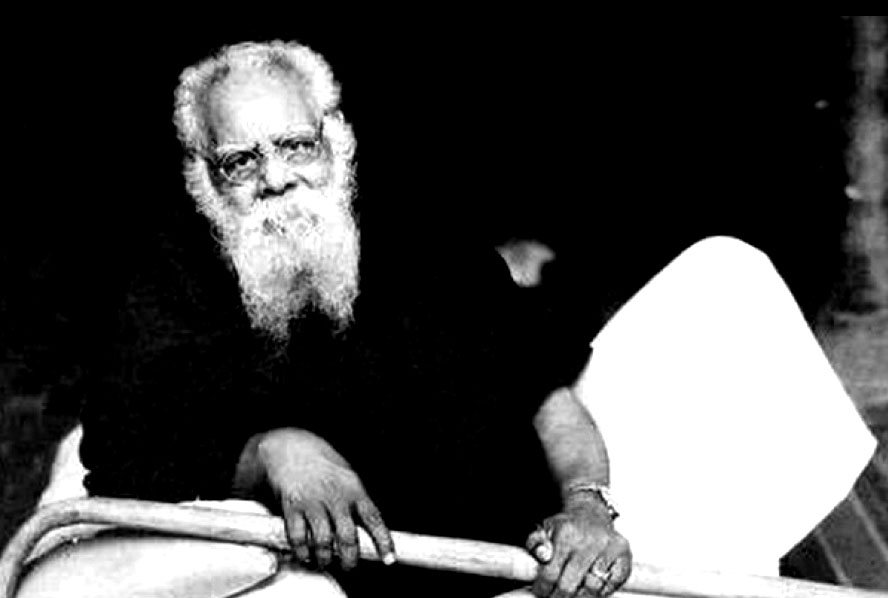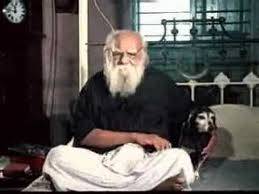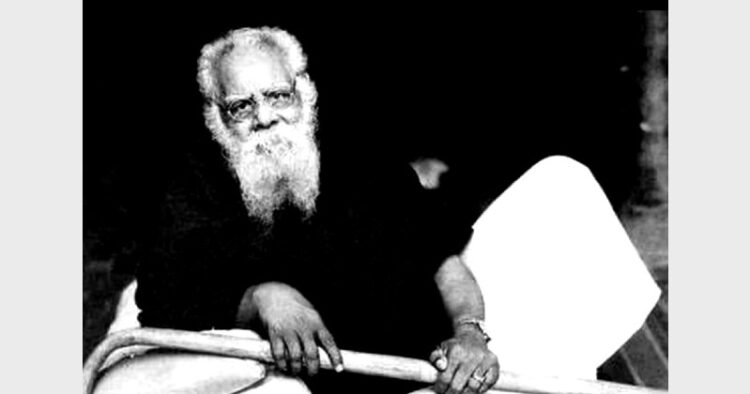“If you see a snake and a Brahmin on the road, Kill the Brahmin first.”— EV Ramaswamy “Periyar”
Agrah Pandit

Aristotle defined hatred as a desire to annihilate the object of hate and termed it incurable. Hatred however has many hues. There is hatred. Then there is pathological hatred such as Hitler’s pathological hatred towards Jews or, well, EVR’s towards Brahmins.
Periyar’s entire world-view was centred around extreme hatred—or say abhorrence—towards Brahmins. Although, he hated Gandhi, Congress, Aryans and Sanskrit as well, but these hues of hatred were second-hand—derived from his hatred towards Brahmins and Brahmanism. The lowest common denominator of all of his hatred was the Brahmin and Brahmanism.
He hated Hinduism as it was nothing but Brahmanism; He hated Congress as it was a party dominated by Brahmins; He hated Gandhi as he was co-opted, well, in a Brahmanical scheme of tyranny and domination. His hatred for Sanskrit and Aryan “race” was similarly derived. Brahmanism stood for a tyrannical, caste-ridden, Sanskritic value system as against egalitarian and non-Brahmanical Tamil value system. The key to his simplistic diagnosis for virtually any problem was his extraordinary talent to spot the role of Brahmins and Hinduism (which was tautological to Brahmanism according to him) there.
EV Rammaswamy (EVR) Naickar made his career by propagating dangers of Brahmin hegemony. He has learnt from colonialists the art and rationale for hating Hinduism. The now discredited Aryan invasion theory was central to his espousal. The Colonialists had understood that they could not defeat India politically unless they defeated it culturally as well. What better way to defeat it culturally than to denigrate the timeless culture, tradition and civilization, known to them as Hinduism. Periyar faithfully followed the lead of Imperialists who had conflated Hinduism solely with ritualistic Brahminism. And as it usually happens, his hatred for Hinduism lead to hatred for the idea of India, of Sanskrit and its great men and traditions. He said, “…the Brahmins who came to our land later, fooled our carefree people, manipulated them to their benefit, enslaved everyone and became their creators and lords.”
The Vedas, according to school-dropout Periyar, were an instrument in hands of invading Aryan Brahmins (possibly of Jew race) to ensnare indigenous Dravidians. An embarrassingly pro-British Periyar believed that it was Brahmins who had actually divided-and-ruled the local Dravidians. Periyar—who opined that North Indian were less brainy than Tamilians citing the proof of Tamil snakes being more venomous and its flowers more fragrant—believed that all superstitions arose because of Hinduism:

Periyar with a Brahmin-repellent pet dog who accompanied him in his public meetings; its utility was to scare away Brahmins who, according to Periyar, considered dogs as unclean
“A careful study of the Vedas, etc., proves beyond doubt that they were written with a view to disgrace, enslave and exploit the Dravidians. It is this Hinduism which says that we are Sudras and Rakshasas. Again it is this Hinduism which is responsible for the introduction of caste distinction and growth of feud among the sons of the soil. All our superstitions and meaningless and absurd rituals and ceremonies are the result of following the tenets of Hinduism.
A believer in Islam as a religion of equality and justice, Periyar urged lower castes to convert to Islam. Baxter has traced Periyar’s support for Islam as an inspiration for the mass conversions of Dalits in Meenakshipuram in 1981. According to him, the Mughals were a force who struggled to destroy Aryan culture for centuries. It is strange that a person could have such a consistent monochromatic vision. On the question of ‘violent nature’ of Islam, he has the following to say:
“Some have written to me objecting that the Mohammedan religion engenders violent nature I am of the opinion, that if this is true, then that itself is a good reason for recommending Islam to the Untouchables in order to abolish their untouchability. If it is true that Islam gives birth to violent tendencies, won’t it be that those who have joined it, at least hereinafter not behave so slavishly? And again, won’t it be that others considering their violent nature would, out of fear, likely to be respectful towards them?”^
Priyar argued that the Indian state and the Brahmins worked together to keep the lower castes as “children of prostitutes”. He opined that brahmanical Hinduism was responsible for virtually all the ills of Tamil society:
“The skulduggery that the priestly class or Brahmins indulge in the name of religion to weaken our unity and expropriate our hard-earned wealth, and ruin our society and country and make us into people without self-respect and living corpses, is nothing less than the damage done to us in the name of politics by politicians and so-called nationalists as I have repeatedly stated.”
Periyar’s version of Ramayana
Periyar was anti-Rama and anti-God precisely because of his anti-Brahminism. He had become an atheist while on a visit to God’s holiest abode, Benares, when he saw Brahmins there indulging in self-serving behavious. His special object of hatred was his own namesake: Lord Rama. He saw in Rama an enforcer of Aryan caste hierarchy. As one commentator says, “For EVR, Rama personifies ‘North Indian values’ and is accordingly identified with North Indian dominance of lower castes and women.” His reading of Ramayana was narrow and propagandist at best: Laxman desirous of Sita; Ravana as a dutiful, compassionate and accountable Dravidian king; Rama as villainous Aryan king; Sita willingly offering herself for abduction by Ravana.
Paula Richman comments thus on lack of even-handedness in his narrative: “Although EVR says that so-called demons like Ravana are in fact admirable Dravidians, Surpanakha’s actions – her open expression of sexual desire, for example – are not praised, nor even mentioned, except as they relate to Ravana’s duty to revenge her honour. EVR is similarly silent about Mandodari, and about Khara, Marica, Dusana, and other of Ravana’s supporters. The fact that EVR spends so much time castigating Rama and his family and so little time praising the actions of Ravana and his family indicates that EVR aroused more ire by lambasting North Indians than by defining and defending precisely what constitutes South Indian culture and identity.”
In 1971 Periyar led a procession at Salem in which cut-outs of Hindu gods, including Lord Rama’s, were slippered and burnt. Born in an orthodox Vaishnavite family but later “converted” to atheism, he would start his meetings with the following mantra:
“There is no God at all.
He who invented God is a fool.
He who propagates God is a scoundrel.
He who worships God is a barbarian.”
Not just Ramayana, he ridiculed the great Tamil classic Silappadikaram: “What is there in Silappadikaram, except the fact that it is a propaganda text of the Aryans? From the commencement to the end it is filled to the brim with Aryan concepts and nothing else.”# He compared “Tamil Veda” Thirukkural to excreta and termed it contrary to rationalism*.
Inspired by Nazis
Described as a “utilitarian with a vengeance,” this evocative Tamil orator equated Jews with Brahmins: “The Jews are only interested in themselves, and nobody else. They somehow contrive to have the rulers in their pocket, participate in governance and conspire to torture and suck the lives out of other citizens in order that they live …Are they not comparable to the Brahmins who too have no responsibility but have the rulers in their pocket, have entered the ruling dispensation and been lording over us?” (March 20, 1938)
And here was a man who was not just all-talk. A powerful organizer and people’s man, Periyar advocated meting out a fascist kind of punishment on Brahmins, in an absolutely racist manner: “Parpanan [a derogatory term for Brahmins] should be driven away from this land,” EVR wrote on 29 January 1954. He further said, “However much a rationalist or atheist, if a person is a Brahmin he should not be allowed in our organizations” (20 October 1967). Further, whatever be the problem, Brahmins have to be made to suffer: “To destroy caste discrimination burn the pictures of Nehru and Gandhi and also the Constitution of India. If all these methods fail to give us results, then we should start beating and killing the Brahmins; we should start burning their houses.”
Modelled after Blackshirts of Fascist Germany, his followers too wore blackshirts—so much love for the Dravidian land whose inhabitants traditionally wore white veshti and shirt and the contemporary India too wore white Gandhain clothes. When Gandhi was teaching the philosophy of turning the other cheeks, and to hate sin not sinner (thievery not thief), Periyar was clear whom to hate:
“Who do you hate? The Brahmin or Brahminism? What is Brahminism?’ – for questions such as these, my reply is Brahminism came from Brahmins and hence it is the Brahmins who should be annihilated. It is like asking whether you hate thievery or the thief. It is because one is a thief, one indulges in thievery. When someone says he hates thievery, it means he hates the thief, too, doesn’t it? Thus, Brahminism grew out of the Brahmin and I am striving to annihilate the root.”
A staunch propagator of racist Aryan-Dravidian theory, he used social problems of his time to build his propaganda. Unecumbered by Political compulsions, he could mouth his invectives at will as he chose to be an unaccountable kingmaker and demagogue who did not enter active politics.
Anti-Gandhi, anti-India, anti-Democracy, pro-Pakistan, anti-Ambedkar
Known as “Thanthai Periyar” that carries the meaning of “Great soul” and “Father,” he was all that the other Great soul (Mahatma) and Father (Rashtra-pita) was not. In fact, as one commentator opines, Periyar’s formula at one time was “listen to what Gandhi says and take a diametrically opposite stand.” He even found Gandhism same as—well, you guessed it right!—Brahminism. He welcomed Simon commission, opposed Salt satyagrah and joined strongly pro-British Justice Party.
Following in the footsteps of Jinnah, he would later demand a separate sovereign Dravida Nadu while supporting the demand of Pakistan. Opposed to the idea of undivided and democratic India, he observed the day of Indian Independence as well as Republic day as days of mourning. Too honest for a man who named his prime newspaper as Kudi Arasu (The Republic) and yet supported continuation of British monarchy. When 44 Dalits were burnt alive in 1968 in Kilvenmani by goons of a landlord, he urged for monarchy to replace democracy; Indian dharma was dharma of criminals…India has gone into the hands of scoundrels after the departure of the British, he would say.
As per Periyar, non-Brahmin national leaders like Gandhi, Subhash Chandra Bose and Sardar Vallabhai Patel, and anyone even slightly opposed to his views were all victims of, well, a Brahmin conspiracy. He even criticized British for falling prey to Brahmin machinations. Gandhi was killed by a Brahmin because Gandhi was turning into a Periyar himself! Opposed to democracy, legislature and newspapers, and unwilling to put faith in people’s power, he said “India should never go anywhere near democratic principles. The reason is 90% of our population are fools and 97% of them are persons of low birth.” He said further: “The entire country is in the clutches of three ghosts and five diseases. God-Caste-Democracy are the three Ghosts. Brahmins-Newspaper-Political parties-Legislatures-Cinema are the five diseases.”
Periyar even accused Ambedkar for selling himself to the Brahmins: “The Brahmins had paid him a price. The price is this: he asked for 10% reservation and they gave him 15%. They knew that even if they gave him 25%, not even three or four percent of qualified people would be available [amongst the Dalits]. He accepted the Constitution written by the Brahmins and signed on the dotted lines. He did not think about others.” Quite a faith in Dalits’ ability, skill and intelligence!
Ever opposed to the then prevailing idea of India, on 17th of October, 1957 EVR wrote that if people following him behaved as obediently as the followers of Mohammad Ali Jinnah, they could win independence. He said that Jinnah won independence by taking up the sword and unleashing rivers of blood, and that they should do the same. He wrote that the Indian constitution will be burned as the first step. If the government still doesn’t budge to his demands, then he will burn Gandhi’s photo and then he will burn the then PM Nehru’s effigy. In response, the then PM Jawaharlal Nehru called ‘Periyar’ as an ‘old and senile man who deserved a place in lunatic asylum rather than in public life.’
This anti-God tried to make himself something of a god by brahmanising all the problems. Obsessed negatively with God, he tried to judge everyone from the standards of God; “To err is human” was simply not acceptable. In the meanwhile, he sought to elevated himself to something like god: he would install his own statues and open his portraits. “I certainly am a Buddha. Why, not only me, all of us who use our reasoning are the Buddhas,” Periyar asserted. And what was Buddhism? —“An atom bomb to Aryanism.”
Periyar delighted himself in nudist camps of Berlin and married a woman less than half of his age when he was in his seventies. He employed the familiar simile while making a cause for female freedom: “Have cats ever freed rats? Have foxes ever liberated goats or chickens? Have whites ever enriched Indians? Have Brahmins ever given non-Brahmins justice? We can be confident that women will never be emancipated by men.” And urged for “manhood to be destroyed”.
Bad in taste, huh? No, these are mild versions of his views. Tamil commentator PA Krishnan opines: “Periyar was a street-fighter, and the things he said in anger are largely unprintable (though it is available in print in Tamil). What he said in cooler moments—rare though they were—are also available. The Periyar that the non-Tamil intellectuals know is a sanitised version of his real personality, lovingly packaged and offered by his admirers.”
^ In all fairness to him, Periyar also said, in the aftermath of the India-Pakistan war: “I say that Pakistani aggression should be defeated … Why? Because Pakistan seeks to annex our land with theirs and intends to make it an Islamic state” (However, he also adds that he would rather welcome a Russian invasion because that would bring communism to India.)
# Tamil scholar Ma Po Sivagnanam (Ma Po Si) defended Silappadikaram against attacks by EVR thus:
So [according to EVR] Kannagi, an individual woman fighting against the miscarriage of justice by a king is an Aryan concept; realizing the miscarriage of justice in his rule, the king voluntarily giving up his life is an Aryan concept; seeing the death of her beloved at once the queen spontaneously dying because of her love is an Aryan concept; Taming the pride of the northern kings who spoke ill of Tamizh is an Aryan concept; Harmonising the politically three-fold divided Tamizh provinces through literature by Illango that is Aryan concept; though born in the lineage of sex workers, Maathavai standing firm in her conviction and love – that is Aryan concept; Kannagi the heroine of the epic is shown as refusing to pray to the deity of love despite being suggested by her Brahmin friend – that is Aryan concept. If all these are Aryan culture set against the so-called Tamizh culture then let us hail that Aryan culture.
* When people answered which book would take place of Thirukkural? He replied: “I am saying remove the excreta emanating bad smell from the room. And you are asking me if we remove this excreta what should we place in its place?’” (Viduthalai, 1 June 1950).













Comments